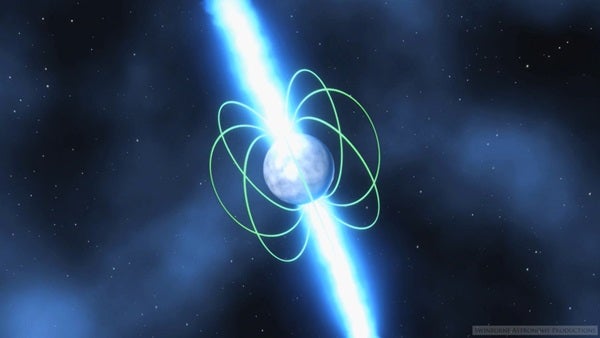The work was published October 31 in the Astrophysical Journal Letters. In it, astronomers observed the closest approach of a pulsar (a rapidly spinning neutron star emitting beams of radiation from its poles), PSR J2032+4127, to its massive Be star binary companion, MT91 213. The system, called a gamma-ray binary system because it produces high-energy light, is one of only two known such systems in which a pulsar and a massive star orbit each other. Further, there are only about 10 known binary systems with a massive star orbiting a neutron star — not all neutron stars are seen as pulsars, which are identified only if the neutron star is oriented in such a way that its poles sweep over Earth as it rotates.
Anticipating fireworks
The two stars in this system are on a 50-year orbit, with the most recent closest approach between the stars occurring November 13, 2017. When dust and gas from the massive companion gets too close to the pulsar, the particles are accelerated to near the speed of light by the pulsar’s intense magnetic field. Those particles then slam into any other particles nearby, generating a flash of gamma rays, which astronomers can detect on Earth. As expected, the number of gamma rays seen from the system increased as the stars approached the closest point in their orbits. But unexpectedly, astronomers saw “a huge spike in the number of gamma rays” as the two stars approached their closest point, said co-author Jamie Holder of the University of Delaware (UD) in a press release. That spike occurred much faster than models predicted, however, and “this tells us that we need to revise the models of how this particle acceleration is happening,” said Holder.
Using the Very Energetic Radiation Imaging Telescope Array System (VERITAS) and Major Atmospheric Gamma Imaging Cherenkov (MAGIC) telescopes, researchers began monitoring the system in September 2016. They watched it through the next year, anticipating the closest approach. In September 2017, observations showed not a slow, slightly variable increase in gamma rays, as models predicted, but a fast increase in gamma rays from the system and wild variability from day to day. “I would wake up every morning and check and see if we had new data, then analyze it as fast as I could, because there were times where the number of gamma rays we were seeing was changing rapidly over a day or two,” said co-author Tyler Williamson, currently a doctoral student at UD.
An unexpected bang
When the closest approach occurred in November, the amount of gamma rays from the system spiked overnight to 10 times the previous day’s levels. That result was completely unexpected, making this system a unique testbed for new theories and models to explain exactly what types of particles are accelerated in this system and how the process occurs. “You couldn’t ask for a better natural laboratory to study particle acceleration in a continually changing environment – at energies far beyond anything we can produce on the Earth,” said Holder. And with so few of these laboratories known, this particular one may be the key to understanding exactly how at least a portion of our galaxy’s gamma rays are produced.
The next time these stars will approach so closely isn’t until 2067. “Tyler is, without a doubt, the luckiest graduate student I’ve ever met because this event that happens only once every 50 years — one of the most exciting things we’ve seen with our telescopes in a decade — occurred right in the middle of his doctoral work,” said Holder. For now, though, the nearly 175 hours of data researchers collected on this closest approach should be enough to keep Williamson — and others — busy for some time.











